International Amphitheatre
The International Amphitheatre was an indoor arena located in Chicago, Illinois, between 1934 and 1999. It was located on the west side of Halsted Street, at 42nd Street, on the city's south side, adjacent to the Union Stock Yards.
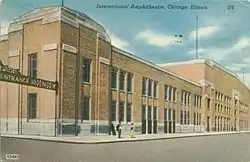 | |
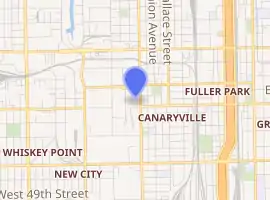
| |
| Location | 4220 South Halsted Street Chicago, Illinois 60609 |
|---|---|
| Owner | Union Stock Yard and Transit Company (until 1983) |
| Capacity | 9,000 |
| Construction | |
| Opened | 1934 |
| Closed | 1999 |
| Demolished | August 3, 1999 (began) |
| Construction cost | $1.5 million ($28.7 million in 2019 dollars[1]) |
| Tenants | |
| Chicago American Gears (NBL/PBLA) (1944–1948) Chicago Packers (NBA) (1961–1962) Chicago Majors (ABL) (1961–1963) Chicago Bulls (NBA) (1966–1967) Chicago Cougars (WHA) (1972–1975) Chicago Sting (NASL) (1976) | |
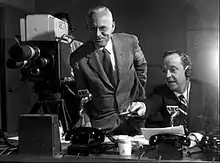
The arena was built for $1.5 million, by the Stock Yard company, principally to host the International Livestock Exhibition. The arena replaced Dexter Park, a horse-racing track that had stood on the site for over 50 years prior to its destruction by fire in May 1934. The completion of the Amphitheatre ushered in an era where Chicago reigned as a convention capital. In an era before air conditioning and space for the press and broadcast media were commonplace, the International Amphitheatre was among the first arenas to be equipped with these innovations.
The arena, which seated 9,000, was the first home of the Chicago Packers of the NBA during 1961–62, before changing their name to the Chicago Zephyrs and moving to the Chicago Coliseum for their second season.[2] It was also the home of the Chicago Bulls during their inaugural season of 1966–67; they also played only one game in the Chicago Coliseum, a playoff game in their first season, as no other arena was available for a game versus the St. Louis Hawks. Afterwards, the Bulls then moved permanently to Chicago Stadium.
The Amphitheatre was also the primary home of the Chicago Cougars of the WHA from 1972 to 1975. It was originally intended to be only a temporary home for the Cougars, but the permanent solution, the Rosemont Horizon, was not completed until 1980, five years after the team folded and a year after the WHA ceased operation. The International Amphitheatre was the home for Chicago's wrestling scene for years as well as the Chicago Auto Show for approximately 20 years beginning in the 1940s.[3][4]
The Amphitheatre hosted several national American political conventions:
- 1952 Republican National Convention (nominated Dwight D. Eisenhower for President and Richard M. Nixon for Vice President; ticket won)
- 1952 Democratic National Convention (nominated Adlai E. Stevenson for President and John J. Sparkman for Vice President; ticket lost)
- 1956 Democratic National Convention (nominated Adlai E. Stevenson for President and Estes Kefauver for Vice President; ticket lost)
- 1960 Republican National Convention (nominated Richard M. Nixon for President and Henry Cabot Lodge, Jr. for Vice President; ticket lost)
- 1968 Democratic National Convention (nominated Hubert H. Humphrey for President and Edmund S. Muskie for Vice President; ticket lost)
The 1952 Republican National Convention had the distinction of being the first political convention broadcast live by television coast to coast, with special studio facilities provided for all the major networks.[5]
The 1968 Democratic National Convention was one of the most tumultuous political conventions in American history, noted by anti-war protests.
Prior to that, the Amphitheatre was noted for being the site of one of Elvis Presley's most notable concerts, in 1957, with the singer wearing his now legendary gold lame suit for the first time.[6]
On September 5, 1964 and August 12, 1966, The Beatles performed at the Amphitheatre. The 1966 show was the first show of what proved to be their last tour.[7]
Indoor wintertime drag racing was held at the Amphitheatre twice, on December 30, 1962 and January 5, 1964. It was fun, but dangerous, because of the slick cement floors. Drag racers need asphalt to get tire grip, launch, and control. The Amphitheatre cement "floor" had very little of these.
On March 13–14, 1976, the Midwest Regional of the North American Soccer League's 1976 Indoor tournament was hosted by the Chicago Sting at the Amphitheater. The Rochester Lancers won the Region to advance to the Final Four played in Florida.[8]
In October 1978, English rock group UFO recorded Strangers in the Night at the International Amphitheatre.
The Stock Yards closed in 1971, but the Amphitheatre remained open, hosting rock concerts, college basketball and IHSA playoff games, circuses, religious gatherings, and other events. The shift of many conventions and trade shows to the more modern and more conveniently-located lakefront McCormick Place convention center during the 1960s and 1970s began the International Amphitheatre's decline; as other convention and concert venues opened in the suburbs, its bookings dropped more.
In December 1981, Joe Frazier had his final boxing match at the Amphitheatre against Floyd Cummings, which resulted in a draw.
Sold in 1983 for a mere $250,000, the sprawling Amphitheatre became difficult to maintain, and proved unable to attract enough large events to pay for its own upkeep. It was eventually sold to promoters Cardenas & Fernandez and then the City of Chicago, which had no more success at attracting events than its previous owner. In August 1999, demolition of the International Amphitheatre began.[4] An Aramark Uniform Services plant is located on the site once occupied by the Amphitheatre.
Image gallery
 The Amphitheatre was adjacent to the Union Stock Yards
The Amphitheatre was adjacent to the Union Stock Yards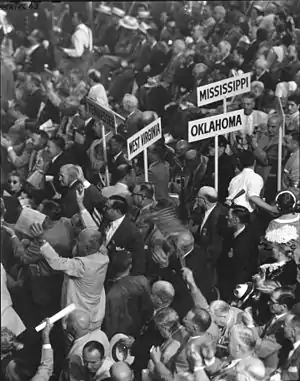 1952 Republican National Convention
1952 Republican National Convention.jpg.webp) Adlai Stevenson during the 1952 Democratic National Convention
Adlai Stevenson during the 1952 Democratic National Convention.JPG.webp) John F. Kennedy nominates Adlai Stevenson at the 1956 Democratic National Convention
John F. Kennedy nominates Adlai Stevenson at the 1956 Democratic National Convention Nixon supporters in Chicago during the 1960 Republican National Convention
Nixon supporters in Chicago during the 1960 Republican National Convention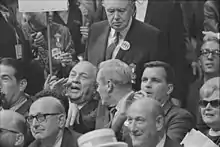 Illinois delegates (including Richard M. Daley and Richard J. Daley) during the 1968 Democratic National Convention
Illinois delegates (including Richard M. Daley and Richard J. Daley) during the 1968 Democratic National Convention
References
- Federal Reserve Bank of Minneapolis. "Consumer Price Index (estimate) 1800–". Retrieved January 1, 2020.
- Hareas, John. "A Colorful Tradition". Washington Wizards. Retrieved 2008-03-19.
- Tito, Rich (April 21, 2004). "Regional Territories-WWA Indianapolis". Kayfabe Memories. Retrieved 2016-02-03.
- Boylan, Anthony Burke (May 30, 1999). "Amphitheatre Gets Its Final Curtain Call". Chicago Tribune. Retrieved 2016-02-03.
- "TV Goes to the Conventions". Popular Mechanics: 94–97. June 1952.
- Cora, Casey (January 8, 2015). "Elvis in Chicago Was 'Electrifying': An 80th Birthday Celebration". DNAinfo.com. Archived from the original on March 16, 2016.
- "Live: International Amphitheatre, Chicago". The Beatles Bible. Retrieved 2016-02-03.
- Milbert, Neil (March 13, 1976). "Opener for the Sting tonight". Chicago Tribune. p. 5, Section 2.
External links
| Events and tenants | ||
|---|---|---|
| Preceded by first arena |
Home of the Chicago Packers 1961–1962 |
Succeeded by Chicago Coliseum |
| Preceded by first arena |
Home of the Chicago Bulls 1966–1967 |
Succeeded by Chicago Stadium |